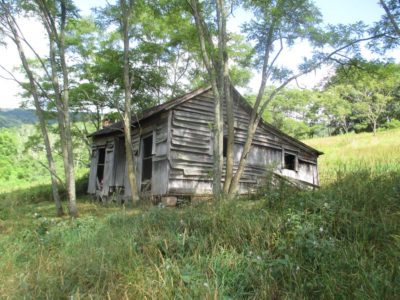
Two years ago in the immediate aftermath of the Studley Tool Cabinet and Workbench exhibit in Cedar Rapids IA, my brother and his son came for a week’s visit at the cabin. As is almost always the case we had a project outlined for our time together. That year the candidate was the dismantling and salvage of an old shack (1920s?) up on the hill about 100 yards from the cabin.
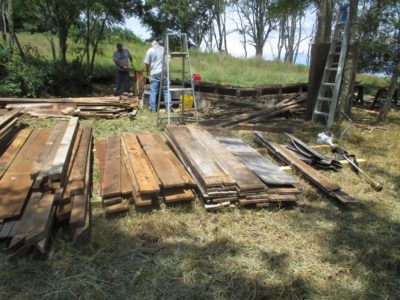
So we went at it. It turned out that all of the roof structure, including sheathing, was chestnut in remarkably good condition. I am not a huge chestnut wood aficionado, but it is a local favorite so into the barn it went. By contrast the wall structure and sheathing were white oak. Primo! The lap siding was also chestnut, and we saved that.
Then I decided to quarrel with a gravel-filled wheelbarrow, and you know the rest of that story.
Flash forward 18 months. Late in winter Mrs. Barn mentioned that she really liked chestnut, and that for her birthday she would REALLY like some custom made frames for the mylar-encased matted art photos we had sitting on the mantle for several years. I said, “Uh-huh,” and left it at that. She of course assumed I had forgotten the incident and request entirely.

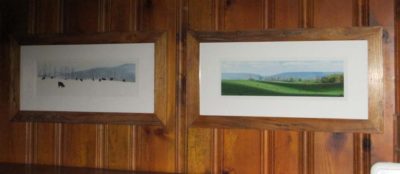
What she did not know was that I had retrieved a 2×4 from the lower barn, milled it, and fabricated frames to fit the photos. Some fussy miter jig work on the table saw followed by a little polissoir and wax action and then shellac and steel wool and the deed was done. Then while she was at Bible Study and yoga one day I finished their framing and glazing and replaced them on the mantle. The next day she had not noticed them so I casually pointed them out.
She was pleased.
From derelict shack to place of prominence; not bad. I’ve still got big piles of chestnut and oak from the salvage project, so who knows what will be coming next. Well, she did give me a list…
As with its previous iterations, Handworks 2017 was a remarkable event and experience, and there is no way to adequately express my admiration and gratitude to Jameel and Father John Abraham for keeping the flame of hand craftsmanship alive. I know that my particular little corner of the event was crowded almost all of the time, and several of the visitors extended very warm thanks and remembrances for the Studley Tool Cabinet exhibit in 2015. Often this was accompanied by exclamations about the magnificence of Jim Moon’s recreation of it, and I was pleased to have played some small part in it being at Handworks.
As I said earlier, there was great interest in traditional finishing and I must have demonstrate wax and polissoir technique roughly 100-150 times. It was heartening to hear the reactions as folks saw and felt the results.
One surprising thing to me was the decided lack of interest in my Roubo First Edition prints from L’art du Menuisier. I would have thought this was the perfect audience for them, but I was no more correct in that presupposition than I was when I predicted John Glenn would be President. I sold only three of the prints during Handworks, and two more outside of the event. Oh well, they will not go bad in their archival sleeves.
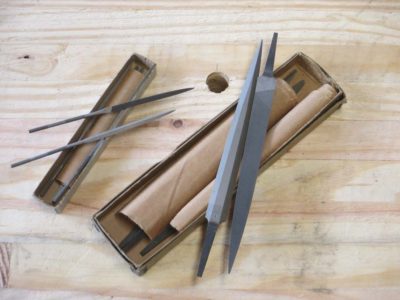
I did manage to come home with a few things myself. First was a stash of barrette files Slav Jelisejevich had among his intoxicating selection of new old stock files. I have no idea what sort of old file underground he is part of but I cannot cross his path without leaving a goodly pile of money behind.
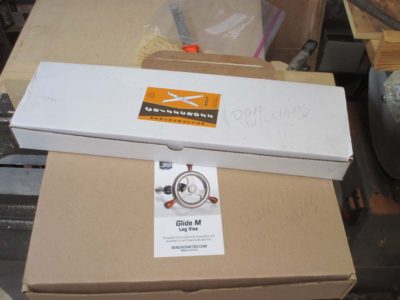
Next was a criss-cross leg vise from our hosts at Benchcrafted. I have not yet decided on which bench to install it. I’m almost afraid to, knowing that if it becomes integral to one bench it might have to be obtained for several others.

Finally is a simple box that that was a gift from Jim Moon. Jim is currently salvaging lumber from an ancient grain mill, and the lumber for my box came from the inside surface of one of the grain chutes. Billions of grain seeds over many decades wallowed out the early wood of this southern yellow pine, leaving an exquisite surface that Jim exploited to its fullest. It is now part of my treasure trove, and the only thing I have left to do is decide whether to make it an artwork on display or a traveling box full of polissoirs and wax.
And that wraps up Handworks 2017.
This is my commandment, That ye love one another, as I have loved you. Greater love hath no man than this, that a man lay down his life for his friends.
The tree of liberty must be refreshed from time to time with the blood of patriots and tyrants.
For that multitude of heroes I have never met, who like my cousin wrote us a blank check and signed it with their blood, I offer my profound thanks and humble honor. — DCW
Make no mistake, Handworks is one of the most important evidences that hand craft is alive and well. Participating as an exhibitor or as an attending aficionado cannot but help to influence you.
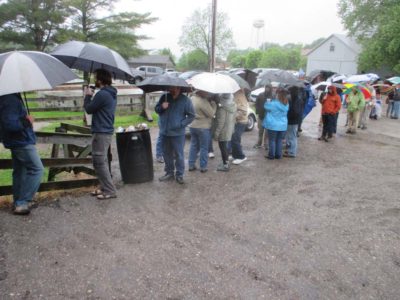
As I walked into the barn at about 9AM both days I witnessed this scene of eager attendees already in line on a cold and rainy day.

By Friday morning everything was set in the venues, or at least in the Festhalle where I was (and I heard similar stories to mine throughout the village).

In the Festhalle there was time for some last minute fellowship among the exhibitors,
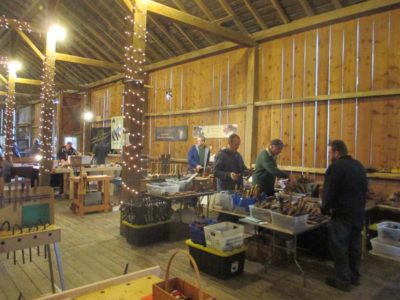
some last minute shopping at other exhibitors’ booths,
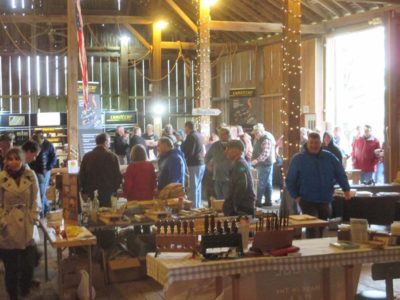
and finally, the entry of a crew of highly enthusiastic woodworkers.
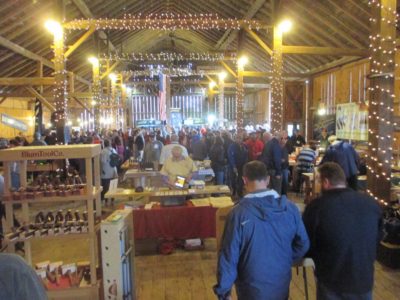
And more woodworkers.
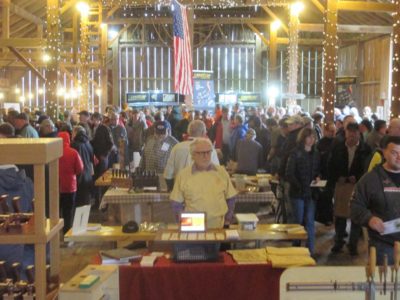
Until it became a mosh pit around us throughout the entire day. I know I was entirely surrounded on all sides until just before closing, standing and greeting and explaining and demonstrating polissoir-and-wax finishing at least 100 times.

Saturday was abuzz with anticipation of The Roy Himself as our featured presenter. The festivities began with Mike Siemsen’s stirring rendition of the National Anthem.
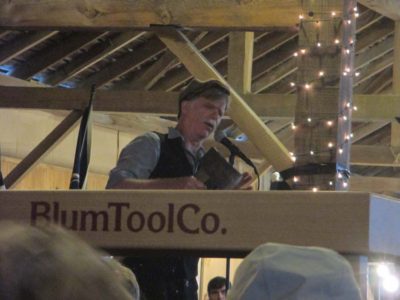
Then came Roy, and of course the crowd loved him.
Throngs to the front of me,

throngs to the back of me (I chatted with one family whose daughter had undergone an appendectomy less that a week before, but she insisted on coming to see Roy Underhill), and even afterwards the affable Mr. Underhill was unfailingly generous with his time and energy visiting with the collected posse throughout the remainder of the day.
At 5PM we broke down the exhibit, disassembled and packed the Roubo benches, and were on the road home by 5.30
Once I got done setting up my little station for demonstrating polissoirs and beeswax finishing, I headed out with my friend Ben to see the other venues for Handworks around Amana. The expansion of Handworks has been astounding, the first one four years ago was confined to the Festhalle, this year included jam packed exhibits and demonstrations at a large room adjacent to the furniture-making shop, the former blacksmith’s shop, the former millwright’s shop, and the open air space for green woodworking and similar.
Our first stop was at the furniture shop, host to carver Mary May, the SAPFM Ohio River Chapter, Mike Siemsen, Jim Moon and his amazing Studley tool cabinet replica, and at least a couple more folks. There wasn’t much going on there just yet. Besides, I forgot to take pictures of the set-up.
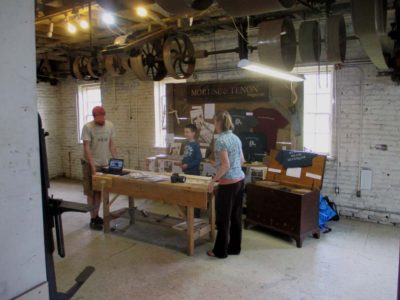

The blacksmith’s shop was starting to fill, with Bad Axe Tools, and Mortise and Tenon magazine. Not all of the exhibitors had arrived.



Moving on to the millwright’s shop found more activity as a variety of folks were already set up, and some, like me, were out strolling the village.
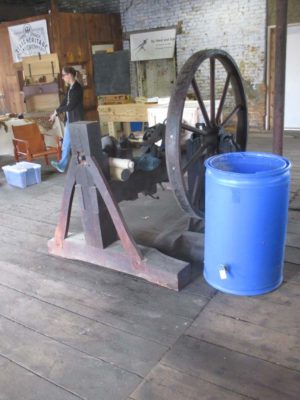
I’m not sure what the story was with this freestanding great wheel, but I would have definitely found a place for it in the barn.
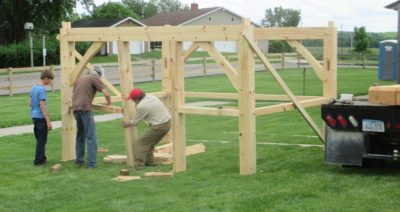

The final stop was the open air space for timber framers, chair makers, and best of all the crew from Norway demonstrating the amazing skottbenk planing beam.

A year ago I did not even know what this was, now thanks to their blog I have to have one! They were the most cheerful group imaginable, happy to be at Handworks and especially to be away from Norway for a while. The snow back home was still nearly knee deep, so they were reveling in the comparitive tropical paradise.

They’d even found a vintage skottbenk at Amana and had it on display at their space.
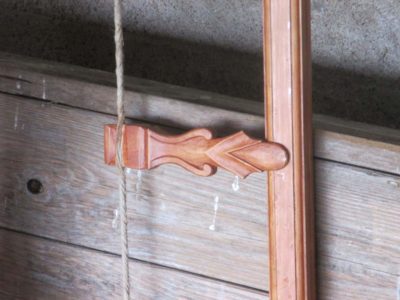
This very showy windlass from a bow saw was from their tool set.

We wandered back to the Festhalle for a final look as things were coming together. This is one of my favorite images of the day, from left Rob Lee, Chris Vesper, and Ben Hobbs chatting.

It was our last breath of calm prior to departing for home on Saturday evening.
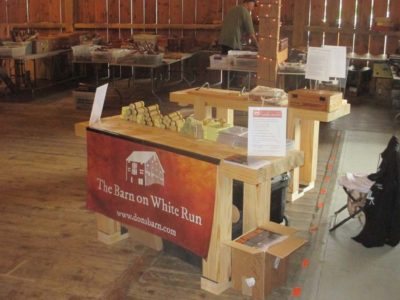
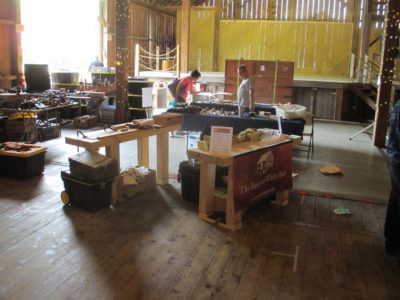
Thursday was the time or setting up at Handworks, and we were one of the first arrivals at the site. That let me get set up and explore the five venues for this bestest toolapalooza ever.
Slowly but surely the exhibitors began rolling in, beginning with my immediate neighbors Jeff Hamilton, maker of marking gauges whose spot was in between me and Lie-Nielson, and planemaker Gary Blum.

Directly adjacent to me across he aisle on one side were plane maker Matt Bickford and the Tools for Working Woods folks.


Across the other aisle was the temptation provided by vintage tool maven Patrick Leach. Much to my own astonishment I managed to avoid the siren song from this booth the entire weekend (admittedly at this point in life my tool needs are modest.)


Directly further up the Festhalle center row was printer and designer Wesley Tanner, the award winning collaborator for both Roubo books and the Studley book.

Along the barn side with Matt Bickford was a booth shared by Konrad Sauer and Raney Nelson, and immediately past them was Lost Art Press/Crucible Tools.
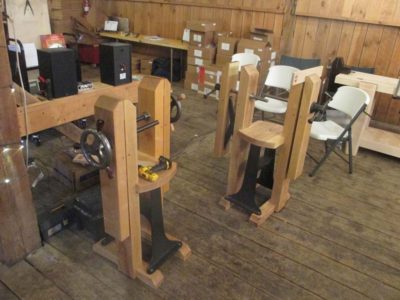
Then came our hosts, Benchcrafted vises and such.
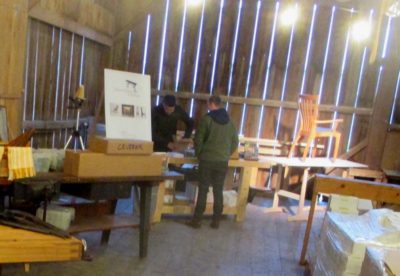
Up in the far corner was designer and furniture maker Jeff Miller, who unfortunately occupied the coldest space in the building. I know, because it is where I was four years ago.
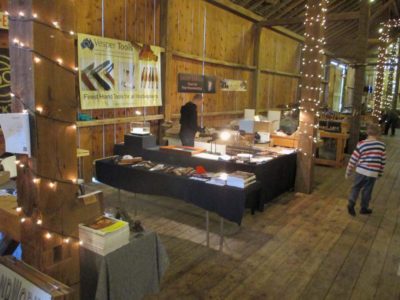
Working down the other outside wall we have Hock blades and precision maven Chris Vesper from Australia, followed by Blue Spruce Tools and David Barron.

The other end of the center row from me included plane maker Ron Brese, tuning up a tool for the masses tomorrow, jig maestro Tico Vogt, and Czeck Edge Tools.
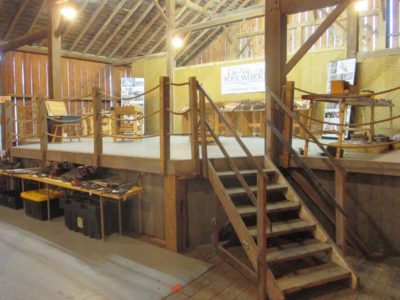

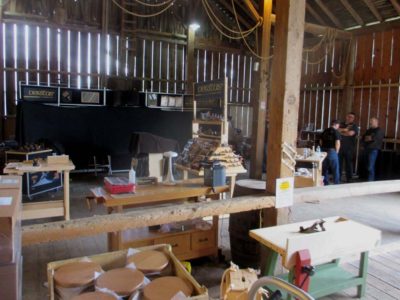
At either end of the hall were the large footprints of Lee Valley Tools and Lie-Nielson Tools. These anchors to the tool-mall guaranteed a spectacular experience for the hordes on Friday and Saturday.
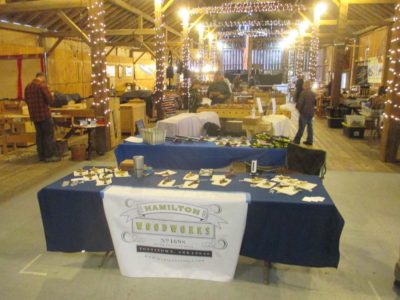
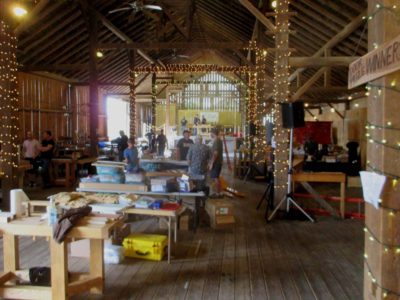
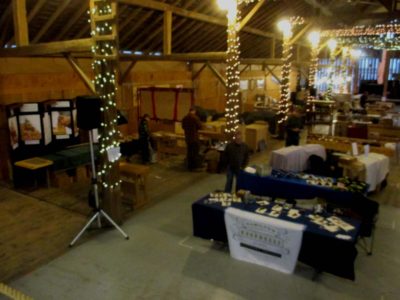
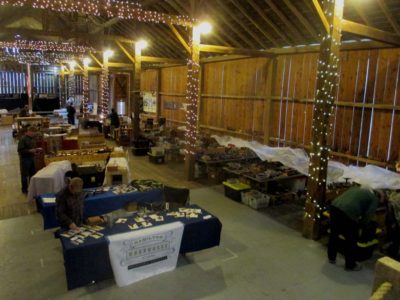
By the end of the day we were all set up, ready for the onslaught in the morning.
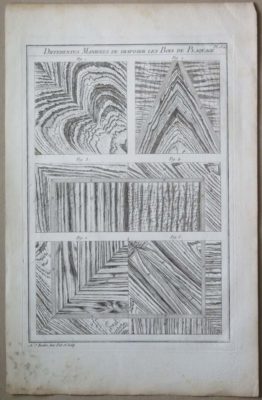
There might be no more visually exuberant print in all of L’art du Menuisier than Plate 284, “Different Ways to Arrange Veneers.” It is only one of many consecutive illustrations wherein Roubo is presenting the principles of composition for parquetry and as he calls it, “simple veneerwork.” The remaining plates in this series are ones I am keeping myself.
Like almost all the prints in my inventory this one was drawn and engraved by Roubo himself.
If you have ever wanted to own a genuine piece of Rouboiana, this is your chance. I will be selling this print at Handworks on a first-come basis, with terms being cash, check, or Paypal if you have a smart phone and can do that at the time of the transaction.
$550

This morning’s offering from L’art du Menuisier is Print 283, “The Ways to Cut Veneers.” It is a delightfully esoteric visual didactic on the orientation of the lumber and the saw to yield the most interesting veneers for the ebeniste.
Like almost all the prints in my inventory this one was drawn and engraved by Roubo himself.
If you have ever wanted to own a genuine piece of Rouboiana, this is your chance. I will be selling this print at Handworks on a first-come basis, with terms being cash, check, or Paypal if you have a smart phone and can do that at the time of the transaction.
$250

Print 282, “The Way of Preparing Frames To Receive Veneerwork,” from L’art du Menuisier is an exquisite introductory tutorial for the ebeniste who needs to know how the selection of veneer application affects the choices he makes in the construction details.
The page is not quite excellent with some minor staining mostly outside the image margins, but is definitely captivating for the concepts it is communicating. I particularly enjoyed the illustrations of incorporating the thickness of veneers into the manner in which doors are fitted into cabinet frames.
Like almost all the prints in my inventory this one was drawn and engraved by Roubo himself.
If you have ever wanted to own a genuine piece of Rouboiana, this is your chance. I will be selling this print at Handworks on a first-come basis, with terms being cash, check, or Paypal if you have a smart phone and can do that at the time of the transaction.
$250
When making the pair of workbenches for use at Handworks this weekend, I decided preemptively to make them considerably lower than I would normally. This is because the bench going to the Library of Congress needed to reflect the stature of the users, which in my observation tended to be considerably less than mine, and I made the second bench more-or-less like the first one.
Going by the old “hanging pinkie knuckle” rubric both benches would be accurate for me at 30 inches. All that shows is that some words, like “rubric,” are not worth the letters it takes to spell them. My preferred bench height is in the 36-37 inch range. So I just do what I recommend you do for yourself; decide hat height is most comfortable and productive for you and make your bench that height.
Back to the benches in question. Since some of the LoC folks are a fair bit shorter than I am, and others are not that much shorter, I decided to make the bench short but with the option of adjusting them up easily and stably. Hence the need for a matched set of high-heeled slippers to go under each leg.
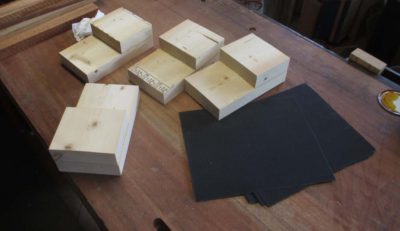
I started with a standard 2×6 and ripped it to 5″ wide, the width of the bench legs. Then I cut the ripped board into the necessary number of sections to make one piece 5″ wide by 4″ long and another 5″ x 8″ for each leg. I glued these together to make a stepped block, or the high-heeled slipper.
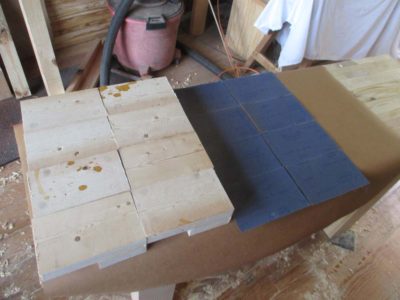
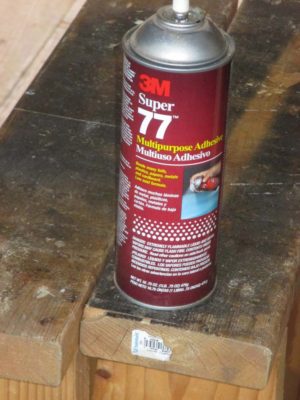
I faced each horizontal surface with medium emery paper (I am guessing about 150 grit) by lightly spraying all the contact surfaces with spray adhesives.

The result is a set of height adjusters that function well and are extremely stable and unobtrusive, allowing the bench to be set-up for working at heights of 30″, 31-1/2″, and 33″.
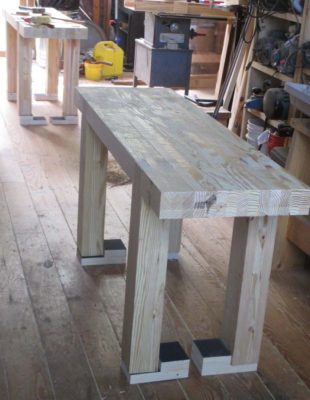



























































Recent Comments